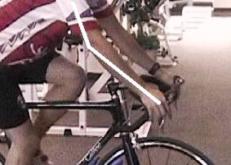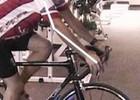How to Get Rid of Cycling Neck and Shoulder Pain
Posted by Matt Russ on 19th Mar 2018

One of the most common maladies that cyclists suffer from is pain in the neck, shoulders, and upper back. Fortunately this one of the easier issues to overcome, either through the fit process or by addressing rider form and technique.
The head is designed to sit on top of the shoulder and by bending the torso forward for long periods of time it is being forced into a position that is somewhat unnatural. The muscles that support the head are mainly postural in nature meaning they are not designed for heavy lifting, but for holding the head in place. So the muscles can and will strengthen and acclimate to hold the position over time. The lower the torso goes the more the head is put forward of the body, instead of on top of it, and the harder they have to work. The most simple solution is to put the cyclists in a more upright position. The only problem with this adjustment is that most of the resistance on the bike is generated by the torso, and the faster you go the more resistance is generated. Simply sitting a rider up is not always a viable option as most cyclists want more speed; and for some this is their foremost goal.
For a performance minded cyclists the goal should be getting the torso in the lowest position that can be ridden comfortably. From a fit standpoint this starts with setting a saddle position. The saddle position and its' relationship with the bottom bracket has a tremendous impact on force production. Saddle adjustment should not be used to address issues above the hips- this is primarily done by adjusting the cockpit such as stem length and angle, bar height, handlebar type, width, rotation, control placement, even bar tape. Note this does not necessarily include saddle angle as a saddle that is angled too far downwards will put excessive stress on the shoulder area as the body has to fight to keep from sliding forward. If you find yourself having to reset your position as you slide towards the nose of the saddle you probably need to adjust your tilt upwards.
A bicycle frame that is too small or too big may be the source of the problem as well. A bicycle has a wide range of adjustability but that only covers so much. Riders often find themselves close to or between frame sizes, and that is ok as the bike may be adjusted to the rider, but a frame that is too large or small will never work.
A stretched position is the primary culprit of this discomfort meaning a cockpit that is too far away from the rider. Generally the upper arm and torso should have about a 90 degree angle between them. A position that stretches the arms out in front of the rider does not have as much leverage to support the torso and causes the muscles to work harder. If the cyclists is desiring a faster (more aggressive) position I do not recommend making drastic adjustments. Taking the rider lower in smaller increments of no more than a centimeter usually allows them to adjust without undo pain and discomfort. Once the cockpit distance from the saddle is adjusted we move on to smaller more ergonomic adjustments such as bar rotation, control position, etc. We may need to change a bar out to one that is wider or more narrow, thicker, or with a shorter drop. There is a very wide variety of shapes and sizes to choose from when it comes to road bike handlebars. Carbon fiber will dampen road vibration more than alloy, and gel pads under the tape, gel backed tape, and gloves with gel padding will also help reduce fatigue caused by road vibration.
I like to observe a cyclists form in a variety of positions on the bike before making adjustments. Beginners tend to suffer from much more pain and discomfort in the neck and shoulders when cycling, and this may simply be from the tight grip they have on the bars. These muscles need to relax and a nervous cyclist will have a death grip on the bars. Once they are more comfortable with the bike, being on the road, and control of the bike a lot of this stress will go away. If the elbows are locked and braced the road vibrations will go straight to the neck and shoulders. A road bike does not have shock absorbers- that is the job of a slightly bent elbow and a relaxed interface with the bike. The elbows should have about a 10 degree bend in them and they should not be flared out but pointed more towards the ground. Also when cycling, the head and neck should not be sunken into the shoulders but in a natural and neutral position. A neutral hand position is one in which the controls fit into the hands as if shaking hands with the bar. Once the neutral position is set I like to mark the rotation of the handlebar with a small dot in-between the stem and faceplate. Using this reference point you can try rotating the bars in either direction in small increments to see what is more comfortable. Note that I often find one shifter is higher/lower or more rotated than the other. It may have moved to this position or not have been set up correctly to begin with. If you find you are having neck and should discomfort on one side this is the first place you should check.
Sharp pain in the neck or shoulders should be addressed medically. This could be caused by a pinched nerve, bulging disc, or other issue. Riding should cease until a proper diagnosis is made. At the very least taking some time off the bike to see if it dissipates is a good place to start.
Addressing neck and shoulder fatigue may require some trial and error. The good news is that a lot can be accomplished without a lot of expense. For instance, shorter or longer bike stems can be purchased for well under $100. Learning better riding form and to relax your position is free. Finally use some common sense in your ride progression. If you are used to cycling for 60-90 minutes and find you have a lot of neck and shoulder pain at the 3 hour mark this may simply be because you ramped up your mileage way to quickly.
Matt Russ is a professional coach with over two decades of experience working with athletes up to the professional level. His athletes have achieved numerous regional, national, and international titles under his direction. Matt has achieved the highest level of licensing by both USA Triathlon and USA Cycling, and is a licensed USA Track and Field Coach. His accomplishments include being named "Team USA" Coach by USA Triathlon. Matt is Head Coach and owner of The Sport Factory, a USA Triathlon Certified Performance Center located in Roswell, Georgia. Visit www.sportfactory.com for more information or email him at coachmatt@sportfactory.com


